Project Management in Action
A Close Examination of the Boeing 737 Max 8

This live webinar was originally presented on Wednesday, November 13, 2019, 1:00 p.m. Eastern, 12:00 noon Central, 10:00 a.m. Pacific. To see a recorded video of that session, scroll down. As this is an ongoing event, we plan to update the information and present it again in the near future. If you are interested, you can signup below.
Summary: Boeing has been in the news often recently, and it is not for any good reasons. The Boeing 737 Max 8 is grounded world wide after two of the planes crashed killing 346 people. This webinar takes a closer look at the development of Boeing 737 Max 8 from a project management perspective. In particular, we focus on three project management topics:
- Project environment – what was the environment in which the development project of Boeing 737 Max 8 was conceived?
- Risk management – what are the key factors leading to the perfect storm resulting in two crashes? What were some of the contributing factors?
- Duty of care – what are the responsibilities of the project professionals, whether they are the project managers, engineers, and aviation professionals to the most important stakeholder – Boeing ultimate customers – YOU?
Description: Boeing 737 Max 8 is in the news frequently days, and not for the good reasons. The plane is currently grounded around the world, and it is unclear when it will fly again. For most of us, the story started with the tragedy of Lion Air Flight 610 that crashed into Java Sea on October 29, 2018 killing all 189 people onboard. Then less than 5 month later, Ethiopian Airlines Flight 302 crashed just six minutes after takeoff, killing 157 passengers and crews. It hit the ground at 575 mph and left a crater 32 feet deep, 92 feet wide, and 131 feet long. Why did this happen? I am here to provide a project management perspective on what led to the tragedy and what every project manager should think about and act in their respective roles.
In 2011, in order to compete with Airbus A320Neo (a recently announced more fuel efficient plane), Boeing embarked on the new design of its 737 plane. To make it more fuel efficient, Boeing followed the essentially the same game plan as Airbus A320 – a bigger and more fuel efficient engine. The trouble for Boeing was that the Boeing 737 is now more than 50 years old and back in the 1967, it wad purposely designed to be closer to the ground for easier repair and loading. There was not enough ground clearance to fit a bigger engine. It’s solution, which led to a series of challenges, was to install the engine higher on the wing.
From a project management perspective, many things went wrong, and we are still learning more everyday. With each new discovery, a new and additional element is found to create this “perfect storm”.
- To start with, the development of the Boeing 737 faced a highly competitive business environment that ultimately led to a series of decisions that leaned toward reduced cost and faster time to market. On cost for example, airlines did not want to retrain their pilots. And Boeing tried to deliver on that promise. This mentality of “keeping the plane operationally the same” took root.
- Throughout the development of the plane, there were incremental design changes each was fairly minor and innocent. But collective, this represented a a significant change to the design of the plane and increased the risk to safety operations.
- FAA who should be the external body that provided the check and balance were using unqualified inspectors. FAA itself reported 16 of 22 inspectors had not finished their formal training and of the 16, 11 did not hold a flight-instructor license, a requirement for the job.
Collectively, these three factors (and there of course we can dive much deeper ito each of these), created the perfect storm that led to a loss of 346 people, a financial nightmare for Boeing, and a severe blow to the reputation FAA, which once was the most admired aviation authority in the world.
What does this mean for project managers?
1. Be aware of the environmental influence on the project. No project is in complete isolation, and most projects are implemented as a response to the environmental changes. In Boeing’s case, it was a response to the Airbus A320. Knowing this acute influence help project managers to make better decisions. So even though most organizations operate under a mindset of limited budget and time, it must also take corresponding considerations like safety, quality, usability, etc. in to the planning and finding the optimal solution.
2. Manage risks. A perfect storm by definition is a confluence of multiple factors. On Boeing 737 Max, there are at least 3 major factors contributing to the killing of 346 people.
3. Duty of care. Last but foremost, project managers need to think about the consequences of their projects. Just like the Flint Michigan’s tainted water situation, the project professionals must think about the ultimate customer – what would lead do to kids in Flint? Here, what if it’s your loved ones on that plane?
Why Attend? Learn about the heightened complexity of risk management and project culture that emerges with large scale projects.
Who Will Benefit? Those with an interest in furthering their knowledge of Risk Management & Culture within a project management environment.
Outcome:
- Learn how business priorities and project culture contributed to woes of the Boeing 737 Max 8.
- Earn 1 PDU
Meet the Presenter
Dr. Te Wu, PMP, PgMP, PfMP, PMI-RMP
Prof. Te Wu is the CEO of PMO Advisory, which is a PMI Global R.E.P. He is an Assistant Professor at Montclair State University, and a visiting professor at CEIBS (Ranked #1 in Asia). Te is certified in Portfolio, Program, Project, and Risk Management and won Honorable Mention in 2015 as Project of the Year by the PMI-NJ Chapter. He is an active volunteer including serving on PMI’s Portfolio and Risk Management Core Team and on ISO TC 258 (on project, program, and portfolio management) as a U.S. delegate. With his vast experience as a practitioner, executive, teacher, writer, and researcher, he is a frequent speaker at professional conferences.
“A Close Examination of the Boeing 737 Max 8”
The following video is a recording of the webinar presented on November 13, 2019. Click here to download the presentation. We also plan to present an updated webinar in the near future, depending on the interest and demand. Please sign-up to express your interest.




